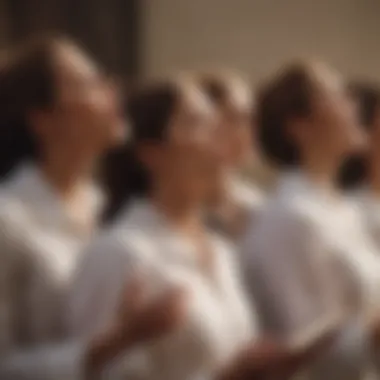The Impact of Christian Anthems on Modern Music Culture


Intro
Christian anthems have long marked the landscape of music, bridging the sacred and the secular. They hold a significant place in both church services and popular culture. This article seeks to examine the role these anthems play today, delving into their historical development and the thematic richness they offer. The juxtaposition of faith-based lyrics with the broad spectrum of contemporary music reveals a layer of cultural resonance that speaks to a wide audience.
Several artists and songs exemplify the influence of Christian anthems in modern music, reflecting diverse experiences and perspectives. By investigating various musical elements and analyzing prominent works, one can uncover the evolving impact these pieces have on listeners.
Artist Profile
Biography and Background
Christian music artists often navigate multiple creative and spiritual realms. They draw from personal experiences and scripted faith tenets, creating art that resonates on multiple levels. Many are not only church musicians but have roots in the secular music industry as well. For example, artists like Chris Tomlin and Lauren Daigle have cultivated expansive careers by blending traditional worship elements with contemporary sounds. This fusion enables them to reach larger audiences beyond church congregations.
These artists frequently cite their upbringing in religious communities as foundational to their artistic expression. Their music often reflects the journey of faith, struggles, and celebrations common to human experience. This narrative-driven approach allows listeners to connect with the themes presented.
Major Influences and Inspirations
The influences on Christian anthem artists are as varied as their music. They often draw from:
- Biblical stories and teachings
- Personal faith journeys
- Diverse musical styles such as pop, rock, and folk
- Other artists in both religious and secular settings
For example, Hillsong United's sound showcases influences from rock and electronic music, while emphasizing worship-oriented lyrics. These inspirations often lead to innovative blends, keeping the genre fresh and relevant.
Song Analysis
Theme and Lyrics Breakdown
Themes within Christian anthems range from praise and worship to introspection and hope. Lyrics often encapsulate a journey through faith, uncertainty, and the search for meaning. A recurring theme is redemption, present in songs like "Good Good Father" by Chris Tomlin, which portrays the loving nature of God amidst human struggles.
A detailed lyrical analysis reveals the structure and emotive language often employed. Repetition plays a significant role, as seen in anthems like "10,000 Reasons (Bless the Lord)". This technique encourages congregation participatio and enhances memorability.
Instrumentation and Composition
Musically, Christian anthems feature a range of instrumentation. Traditional elements include:
- Acoustic guitars
- Pianos
- Percussion
- Synthesizers
Modern arrangements often incorporate electronic components, expanding the sound palette. The composition typically centers on a verse-chorus structure that reinforces lyrical themes effectively. The integration of rich vocal harmonies is another hallmark, creating an immersive experience for listeners.
"The power of Christian anthems lies in their ability to inspire unity among diverse audiences while providing a platform for shared values and beliefs."
The connection between the music and its spiritual context cannot be understated. Each anthem not only serves as a personal reflection but also as a collective expression of faith among believers.
Through exploring the narratives, themes, and musical nuances, we can better understand how Christian anthems resonate with contemporary audiences across various backgrounds.
For those interested in observing these influences firsthand, platforms such as Wikipedia, Britannica, Reddit, and Facebook can provide further insights into this impactful genre of music.
Prelude to Christian Anthems
Christian anthems hold significant value in both religious settings and the broader music landscape. These pieces not only serve as vehicles for worship but also create connections among diverse listeners. Understanding this concept helps appreciate their depth and impact on musical trends. The exploration of Christian anthems is crucial because it reveals how faith-based music has evolved, transformed, and integrated into popular culture.
Definition and Characteristics
Christian anthems can be defined as songs that express themes central to the Christian faith. They typically highlight aspects like worship, devotion, and celebration. Common characteristics of these anthems include rich melodies, emotionally resonant lyrics, and often, arrangements that invoke a sense of community. The music frequently employs repetition, which aids in memorization and collective singing. Additionally, the instrumentation may vary widely from traditional organs and choirs to modern guitars and synthesizers.
Christian anthems can be broadly classified based on their function in worship. They fall into categories such as hymns, praise songs, and modern worship anthems. These categories reflect both the lyrical content and the musical style, allowing for a range of expressions within worship.
Historical Origins
The origins of Christian anthems trace back centuries, with roots in early Christian liturgy. Throughout the Middle Ages, music played a pivotal role in religious ceremonies. Gregorian chants were amongst the earliest forms, characterized by their monophonic structure and spiritual focus. As time progressed, hymns began to take shape during the Protestant Reformation, highlighting the importance of congregational singing.
The 18th and 19th centuries saw the rise of composers like Isaac Watts and Charles Wesley, who contributed significantly to hymnody. These individuals composed texts that resonated deeply with believers, focusing on personal connection with God. The advent of gospel music in the early 20th century introduced new rhythms and styles, bridging traditional hymns with modern sensibilities.
Today, contemporary Christian music continues to evolve, influenced by various genres including pop, rock, and hip-hop. This evolution reflects both the changing cultural landscape and the desire for relevance among new generations of Christians. Understanding these historical origins offers insight into how Christian anthems maintain their significance and continue to resonate with audiences today.
Role of Christian Anthems in Worship
Christian anthems play a crucial role in worship settings. They serve not merely as musical pieces but as heartfelt expressions of faith. These anthems bind communities through shared beliefs and enhance the spiritual experience of worshippers. Their significance can be observed in various essential elements, including their liturgical role and their capacity to foster communal identity.
Liturgical Significance
The liturgical significance of Christian anthems cannot be understated. During worship services, these songs often accompany rituals and sacraments. The lyrics reflect core tenets of Christianity and provide theological grounding. Worshipping through music allows congregants to engage more deeply with the messages of the liturgy. Commonly, anthems are sung during significant events, such as Communion or baptisms, reinforcing the spiritual importance of these moments.
Christian anthems also vary according to different liturgical calendars. For example, during Lent, many congregations may choose songs that focus on themes of penitence and reflection. This adaptability ensures that the worship experience remains relevant to the congregation throughout the year.
- Enhancing Atmosphere: The music sets the mood, making solemn moments feel even more sacred or joyous celebrations even more uplifting.
- Promoting Unity: Singing together fosters a sense of belonging among worshippers.
Community and Identity


Christian anthems are central to shaping community and identity within congregations. These songs are often vehicles through which people express collective experiences and values. The act of singing together encourages bonding among congregation members. Through anthems, individuals find a sense of belonging, and this unity is a critical aspect of communal worship.
Furthermore, anthems often evoke memories and feelings unique to that community. Many congregations have signature songs that become part of their identity. For instance, a particular anthem might be linked with a significant event or rally in the community's history. This nostalgic connection enhances the depth of worship and continues to build communal ties.
"Music can express the inexpressible. Through anthems, congregations communicate their hopes, struggles, and faith in a profound way."
The interaction between music and worship also shapes how faith is transmitted to younger generations. Teaching these anthems to children keeps traditions alive and cultivates a continued sense of identity within the community, fortifying the church's legacy.
In summary, the role of Christian anthems in worship transcends mere sound. They are a significant aspect of the liturgical experience and a vital means for building community and identity. Their impact on the congregation's collective experience shapes not only how members interact but also how they express their faith.
Themes in Christian Anthems
Christian anthems serve as a rich medium for spiritual expression, often encapsulating profound themes relevant to individual and collective experiences. The themes prevalent in these songs often focus on faith, redemption, hope, and encouragement. They provide listeners with a framework to process their emotional and spiritual journeys. As audiences engage with these anthems, they find connections that can aid in understanding their faith and experiences in a modern context, enriching the communal aspect of worship.
Faith and Redemption
Exploring Grace
Exploring Grace within Christian anthems revolves around the theme of unmerited favor. It highlights how grace transcends human limitations, offering solace in times of trial. The message often evokes a sense of relief and hope among listeners, making it a central figure in many contemporary worship songs.
The key characteristic of this theme is its ability to resonate with personal experiences of forgiveness and unconditional love. It becomes a beneficial choice for this article, as grace anchors many believers in their faith journey.
One unique feature of this theme is its capacity to invite introspection. Listeners often reflect on their lives and discover deeper meanings in the lyrics. This can lead to personal transformation but may also hold the risk of oversimplifying complex theological concepts for some audiences.
Redemptive Narratives
Redemptive Narratives in Christian music tell stories of transformation and salvation that resonate deeply with listeners. They often recount personal or collective experiences of overcoming adversity through faith. These narratives contribute significantly to the understanding of faith as a living, dynamic journey.
The key characteristic of Redemptive Narratives is their compelling storytelling. This makes them a popular choice because stories engage listeners on multiple levels, evoking emotional responses that facilitate a connection to the themes presented.
These narratives' unique feature lies in their relatability; they often mirror real-life struggles and victories in faith. While they inspire hope, they can potentially be seen as trivializing genuine suffering if not approached with care in worship contexts.
Hope and Encouragement
Messages of Perseverance
Messages of Perseverance found in Christian anthems encourage listeners to persist through life's challenges. They provide a soundtrack for resilience and strength, reminding individuals that they are not alone in their struggles. This theme contributes significantly to uplifting community spirit and personal resolve.
The key characteristic of this theme is its empowering nature. Highlighting perseverance aligns with a broader understanding of faith as not just belief but active engagement in life's challenges. This makes it a relevant topic for this article, as such messages are increasingly resonant in today’s society.
Unique features of these messages include their ability to foster a sense of solidarity among listeners. While they encourage personal strength, they might sometimes risk oversimplifying complex situations, creating unrealistic expectations around perseverance alone.
Community Support
Community Support is another vital theme in Christian anthems that fosters a sense of belonging. Many songs focus on the power of shared faith and love, emphasizing the strength of a united community. This theme underlines the social dimension of worship, where individuals support one another through trials.
The key characteristic of Community Support is its ability to build emotional bonds. This makes it a beneficial aspect of this article, as it highlights the importance of connection in faith communities. These anthems can become anthems for inclusivity and belonging.
A unique feature of this theme is its accessibility. When sung in groups, these songs can create a powerful feeling of unity. However, they may also challenge individuals who face exclusion within faith communities, reminding us that inclusivity needs continuous attention.
"Christian anthems serve as an outreach, not only to the divine but also to human connection."
In summary, the themes of faith, redemption, hope, and community stand as cornerstones in understanding the power and resonance of Christian anthems in contemporary music. These aspects shape how individuals relate to different life realities, providing not just a musical experience but a pathway to deeper faith engagement.
Influential Christian Anthems
Understanding the significance of influential Christian anthems is crucial for exploring their impact on both religious and secular music landscapes. These songs not only inspire spiritual growth but also bridge gaps between diverse cultural and musical communities. They serve as a testament to the enduring power of faith expressed through music, highlighting how these anthems transcend denominational boundaries and connect with a wider audience.
Historic Anthems
Classical Roots
The classical roots of Christian anthems are profound in their contributions to the genre. Composers from the Baroque and Renaissance periods laid the groundwork for many of the hymns we know today. One important characteristic of classical roots is their reliance on rich harmonic structures and vocal polyphony, which enhance the emotional depth of the music. This sophisticated approach makes these pieces timeless and appealing, whether in church settings or concert halls.
Additionally, classical arrangements often employ orchestral elements that enrich the auditory experience. This unique feature allows for varied interpretations and performances, making them versatile for different occasions. The disadvantage, however, is that these anthems sometimes require extensive training and resources, making them less accessible for casual or contemporary musicians.
Iconic Hymns
Iconic hymns hold a revered position within Christian music. They represent fundamental themes of faith, love, and hope, drawing listeners in with their simple yet profound messages. Their memorable melodies and straightforward lyrics contribute to their enduring popularity. These hymns typically focus on universal themes that resonate with a broad audience, serving as a reminder of the core values of Christianity.
The unique feature of iconic hymns is their ability to be adapted across various musical styles. From traditional church choirs to modern worship bands, these hymns have a remarkable versatility. However, the challenge lies in keeping these hymns fresh and relevant in a fast-evolving musical landscape. Their performance in contemporary settings may sometimes face scrutiny for being too traditional, yet their legacy continues to inspire new interpretations.
Contemporary Anthems
Modern Worship Songs


Modern worship songs have gained significant traction in recent years, reflecting a shift in how faith is expressed musically. These songs often incorporate contemporary sounds, making them relatable to younger audiences. A key characteristic of modern worship songs is their emotionally charged lyrics, which foster a personal connection between the singer and God. This aspect is particularly beneficial as it encourages participation and engagement during worship services.
Their unique approach often blends various genres, such as pop, rock, and folk, creating an accessible entry point for new listeners. However, the risk with modern worship songs is their potential commercialization, which can sometimes overshadow their spiritual intent. Balancing accessibility with authenticity remains an ongoing challenge for writers and musicians in this genre.
Top Artists and Groups
Top artists and groups in the Christian music scene play an essential role in shaping the landscape of contemporary anthems. Notable names like Hillsong United, Chris Tomlin, and Lauren Daigle have influenced how songs are composed and presented. These artists are known for their ability to craft music that profoundly impacts their listeners, blending personal storytelling with communal themes of worship.
One prominent feature of these artists is their devotion to producing music that encourages faith-driven living. Their songs often reach beyond the church, attracting attention on mainstream music charts. However, this crossover can pose questions about maintaining the integrity of their message amidst commercial success. Exploring new musical territories while staying true to core Christian values is an ongoing balance they must navigate.
"Influential Christian anthems not only shape worship practices but also resonate deeply with the cultural zeitgeist, reflecting broader societal themes."
In summary, the study of influential Christian anthems offers valuable insights into their historical roots and contemporary expressions. Both historic and modern anthems contribute to a rich tapestry of musical expression that continues to evolve while remaining anchored in faith.
The Impact of Technology on Christian Anthems
The influence of technology on Christian anthems is significant. It has transformed how these songs are created, distributed, and experienced. In today’s world, technology plays a crucial role in shaping not only the sound but also the reach of Christian music. This section explores two main aspects: digital distribution and the influence of social media.
Digital Distribution
Digital distribution has revolutionized how Christian anthems enter the marketplace. Gone are the days when physical copies of albums dominated. Artists can now upload their music to platforms like Spotify, Apple Music, or Amazon Music, reaching vast audiences instantly. This mode of distribution lowers barriers for emerging artists, providing them an opportunity to share their faith and artistry with a global audience.
The ease of access to Christian anthems means listeners can discover new music easily. Many genres and styles coexist in the digital realm, allowing for greater experimentation and interaction within Christian music. For musicians, this presents an opportunity to engage fans through various formats such as singles, EPs, and live recordings without the significant upfront costs of traditional album production.
While the benefits are considerable, there are challenges as well. The sheer volume of music available can lead to saturation and make it difficult for individual anthems to stand out. However, skilled artists utilize data analytics available through streaming platforms to understand audience preferences and refine their work accordingly.
"The digital world is not just a market; it’s a community that shapes music creation today."
Social Media Influence
Social media influence is another key facet in the realm of Christian anthems. Platforms such as Facebook, Instagram, and TikTok allow artists to cultivate an audience and share their messages in real time. Social media serves as a powerful promotional tool, enabling musicians to showcase new releases, share stories behind their songs, and engage with fans directly.
Moreover, viral trends often shape the success of specific anthems. A moving performance shared on social media can resonate with viewers, leading to widespread adoption of a song. This is particularly salient in the case of worship songs which can gain traction through shared experiences in church communities and beyond.
Additionally, social media fosters cross-cultural collaborations among artists from diverse backgrounds. This blending of styles enriches the musical landscape and introduces new themes pertinent to different audiences, further expanding the reach of Christian anthems.
Christian Anthems Across Music Genres
Understanding the relationship between Christian anthems and various music genres is essential to grasp their impact on contemporary culture. Christian anthems have shaped and been shaped by diverse musical styles, achieving resonance with audiences in differing contexts. This cross-genre exploration demonstrates how these anthems serve not only as religious expressions but also as pieces of artistic culture that engage a wider audience.
The versatility of Christian themes allows them to be incorporated into various musical styles, creating a unique blend that resonates with both secular and religious crowds. Examining the intersections of faith and music reveals how spirituality can transcend boundaries, fostering connections across differing communities. Through pop and rock elements, Christian anthems have reached broader demographics, making their messages more accessible.
Pop and Christian Music
Pop music, characterized by its catchy melodies and relatable lyrics, has seen the significant inclusion of Christian themes. Artists like Chris Tomlin and Carrie Underwood have successfully merged mainstream pop with traditional Christian lyrics, enhancing the reach of these anthems. This blend not only captures the attention of listeners but also introduces them to Christian concepts in a format they enjoy.
Further, many pop songs feature lyrics that resonate with messages of hope, love, and redemption, which are foundational to Christian teachings. This alignment has promoted the popularity of albums such as "Awake" by Hillsong Young & Free, which blends electronic pop with deep spiritual messages, attracting a youthful audience that may otherwise feel disassociated from traditional religious expressions.
Considering the benefits, the fusion of pop and Christian music allows for:
- Wider Reach: Attracts audiences beyond church walls.
- Engagement: Offers relatable themes that can inspire discussion or personal reflection.
- Innovation: Encourages new sounds and collaborations that keep the music fresh and relevant.
Rock and Worship
Rock music brings a different energy to Christian anthems, often characterized by its powerful instrumentation and passionate delivery. Bands like Switchfoot and Skillet exemplify how rock can serve as a vessel for worship, presenting formidable anthems that resonate with the energy of contemporary culture while remaining firmly rooted in faith.
The use of electric guitars, drums, and a more assertive vocal style engages listeners emotionally, making worship feel dynamic and intense. This genre provides an avenue through which worship experiences can be expressed without traditional constraints, appealing to a generation looking for authenticity in their spiritual practices.
Key aspects of rock and worship include:
- Lyrical Depth: Exploration of challenging themes like doubt, struggle, and trauma offers a raw and genuine approach to faith.
- Community Connection: Concerts create communal worship experiences that break down barriers and encourage collective faith expression.
- Cultural Relevance: Aligns with movements in broader society, making the messages feel pertinent to current events and personal struggles.
These genres highlight the adaptability of Christian anthems and their ability to reach audiences across diverse musical backgrounds, ensuring the continued relevance and resonance of Christian themes in modern music.
Controversies Surrounding Christian Anthems
The topic of controversies surrounding Christian anthems plays a vital role in understanding their resonance in contemporary music. These anthems are not just religious expressions but also cultural artifacts that elicit various reactions. As a result, they become focal points for debate within the music community and beyond.
Cultural Appropriation
Cultural appropriation is often discussed in relation to Christian anthems. This concept involves the adoption of elements from one culture by members of another culture, typically without permission or understanding. In the context of Christian music, one might see certain styles or themes borrowed from different cultural traditions, sometimes causing friction.
Critics argue that this borrowing can lead to a diluted sense of authenticity. For instance, if a popular worship song incorporates traditional African rhythms without acknowledgment, it may contribute to a superficial engagement with that culture. Conversely, proponents of such musical blends argue they can create bridges between cultures, encouraging diversity in worship and expression.
Some key points to consider about cultural appropriation in Christian anthems include:


- Authenticity vs. Homogenization: How does the blending of styles affect the original meanings and values of those cultures?
- Representation: Are artists from the cultures being borrowed from given appropriate voice and recognition?
- Influence on Audience: Does cultural appropriation affect how listeners respond to the music? Are they aware of its origins?
Commercialization of Faith
Commercialization of faith within Christian anthems is another significant controversy. The intersection of religion and commerce often raises ethical questions. Critics claim that when Christian music becomes a commodity, it risks losing its spiritual essence. The focus might shift from worship to sales, which can undermine the intent behind the music.
Examples of this can be seen in the vast array of merchandise linked to popular Christian artists, concert tours, and even branded worship experiences. This commercialization raises several concerns:
- Motivations of Artists: Are musicians driven by faith or profit? The line may become blurred, leading to skepticism among listeners.
- Impact on Worship: If the primary aim of creating music is financial success, what happens to the authenticity of the worship experience?
- Access to Music: As artists seek to profit, does it create barriers for access? Not all communities can afford expensive concert tickets or exclusive content.
"When faith meets market dynamics, the simple act of worship can transform into a commercial spectacle, distancing believers from genuine expression."
In summary, the controversies surrounding Christian anthems highlight the complexities involved. Whether it is the concern of cultural appropriation or the commercialization of faith, these elements provoke critical discussions. Understanding these controversies can enrich one's appreciation of the music and its place in contemporary society.
Global Perspectives on Christian Anthems
The concept of global perspectives on Christian anthems is pivotal in understanding their overall impact and evolution within contemporary music. As music transcends national borders, the influences blend and shape the themes and styles of these anthems in various cultures. Identifying how different regions interpret and adapt these musical forms highlights the dynamism of faith-based music today. This section will delve into the multifaceted nature of Christian anthems around the world, showcasing their diversity and the universal messages they often convey. Through this examination, we can explore the rich tapestry of cultural expressions, all while maintaining a connection to their spiritual roots.
International Variations
Christian anthems vary greatly from one country to another, each region bringing its unique traditions and musical genres into the mix. For instance, in the United States, the fusion of gospel, blues, and rock has resulted in powerful worship songs that carry a strong emotional weight. Meanwhile, in African nations, rhythmic patterns and instruments specific to local customs bring vibrancy and energy to worship music. These variations are not only a reflection of local culture but also a response to the globalized nature of music today.
- Regional Styles: Each area has its distinct sound, shaped by historical and social contexts. For example, West African anthems often use traditional instruments like the djembe, while South American songs often incorporate elements from samba and favelas.
- Linguistic Diversity: Christian anthems are also expressed in various languages, from English in North America to Portuguese in Brazil, further enriching the tapestry of themes explored in these songs.
This diversity enhances the emotional resonance of Christian anthems, as listeners connect with songs that speak to their unique experiences, beliefs, and customs.
Cross-Cultural Collaborations
The future of Christian anthems lies increasingly in the realm of cross-cultural collaborations. This synergy allows artists from different backgrounds to unify their voices, creating music that celebrates both diversity and commonality in faith. Collaborations often lead to innovative compositions that blend musical forms, producing a novel sound that appeals to a broader audience.
These partnerships can take various forms:
- Artist Collaborations: Renowned figures like Lauren Daigle and Chris Tomlin have teamed up with international artists to create songs that span cultural boundaries. Such collaborations often culminate in tracks that merge diverse styles, enhancing their appeal.
- Community Projects: Initiatives aiming to join various community choirs across the globe demonstrate the power of collective worship through music. These gatherings produce unique versions of traditional anthems, further emphasizing the importance of collaboration in modern Christian music.
"The beauty of Christian anthems lies in their ability to connect us across cultures, illustrating the universal truth of faith while celebrating individual expressions."
In summary, examining global perspectives on Christian anthems reveals a rich landscape of musical expression. By studying international variations and fostering cross-cultural collaborations, it becomes evident that these anthems are not just localized artifacts but global phenomena that resonate with a diverse audience.
Future Trends in Christian Anthems
As Christian anthems continue to evolve, understanding the future trends in this space becomes essential. This section delves into the emerging artists and the evolving themes and styles that are shaping the sound of contemporary Christian music. By discussing these trends, we can grasp the ongoing transformation within the genre and its broader implications on both religious and secular music contexts.
Emerging Artists
Today, the landscape of Christian music is defined by new voices. Emerging artists are finding innovative ways to express faith through music. Many of these individuals come from diverse backgrounds and musical genres. This diversity fosters a more inclusive and expansive sound. New artists often experiment with multiple styles, creating a blend that resonates with different audience segments. For example, artists like Lauren Daigle and KB incorporate elements of pop, hip-hop, and R&B into their work, attracting listeners beyond traditional church settings.
Notably, platforms such as Spotify and YouTube serve as launchpads for these emerging artists. The accessibility of digital music distribution allows them to reach global audiences quickly. Some artists capitalize on social media to build a following and share their music. Their relatable content and engaging performances often lead to rapid popularity.
Evolving Themes and Styles
As Christian anthems progress, the themes and styles also shift to reflect contemporary realities. Modern Christian music increasingly addresses issues like mental health, social justice, and personal struggles. The goal is not just to uplift but to connect on a deeper emotional level.
For instance, songs that deal with the complexities of faith amid doubt resonate strongly with listeners. They evoke heartfelt responses and invite introspection. Additionally, collaborative projects between different genres are becoming more common. This fusion of styles enriches the musical experience. Genres such as electronic, indie, and even alternative rock increasingly incorporate Christian elements, indicating a move towards a more universal expression of faith.
The use of technology in music production also plays a critical role in shaped evolving styles. New software and tools have democratized music creation, giving rise to unique soundscapes. Artists now have the ability to experiment with sounds and production techniques that were once inaccessible to many.
"The future of Christian anthems lies in the voices of those who dare to innovate while remaining grounded in their faith."
These trends suggest that Christian anthems are not merely a niche but are becoming integral to the broader music culture. The incorporation of new ideas, themes, and technologies in anthems will likely continue to attract diverse audiences, ensuring their lasting resonance in a rapidly changing musical landscape.
Culmination
The conclusion of this article serves to encapsulate the enduring significance of Christian anthems in both historical and modern contexts. It highlights how these anthems have evolved while maintaining their core message of faith and hope.
The Enduring Legacy of Christian Anthems
The legacy of Christian anthems is profound and multifaceted. Their origins can be traced back centuries, intertwining with the very fabric of Christian worship and community life. These songs did not merely serve as a musical accompaniment; they played a crucial role in shaping theological understanding and communal identity.
Christian anthems have consistently provided a means for worshippers to express their spirituality. Iconic hymns such as "Amazing Grace" and "How Great Thou Art" have transcended generations, their lyrics resonating with the core of Christian belief. This legacy continues to thrive, finding its way into contemporary music forms. Musicians like Chris Tomlin and Lauren Daigle take foundational themes and remix them for modern audiences, hence fostering an ever-evolving relationship between the core messages of Christian faith and today's music landscape.
The ability of Christian anthems to adapt while still preserving their original meanings ensures their continued relevance.
Indeed, this adaptability is a hallmark of their enduring legacy, attracting diverse listeners beyond the church walls.
Continued Relevance in Contemporary Culture
Christian anthems hold significant relevance in contemporary culture, influencing not just religious communities but also the broader music scene. As society embraces various expressions of spirituality, these anthems provide a touchpoint for conversations around faith, identity, and community.
Modern platforms, such as streaming services and social media, facilitate the dissemination of Christian music far and wide. Songs that echo themes of hope and resilience are often on the lips of many, including those who may not identify as religious. The lyrical content of modern Christian music often addresses universal themes that resonate with the human experience.
"Music transcends barriers, and Christian anthems amplify messages of love, unity, and redemption."
In this way, anthems can serve as catalysts for connection in an increasingly fragmented world. Christian artists are at the forefront of merging styles—from pop to rock to hip-hop—demonstrating the universality of their messages. The blend of faith and artistry not only enriches personal worship experiences but also engages a wider audience in meaningful discussions about faith and spirituality.







